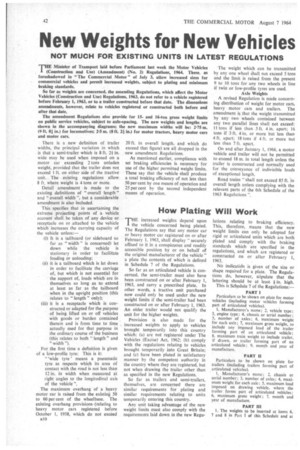New Weights for New Vehicles
Page 44

If you've noticed an error in this article please click here to report it so we can fix it.
NOT MUCH FOR EXISTING UNITS IN LATEST REGULATIONS
THE Minister of Transport laid before Parliament last week the Motor Vehicles
I (Construction and Use) (Amendment) (No. 2) Regulations, 1964. These, as foreshadowed in "The Commercial Motor" of July 3, allow increased sizes for commercial vehicles and permit increased weights, subject to plating and minimum braking standards.
So far as weights are concerned, the amending Regulations, which affect the Motor Vehicles (Construction and Use) Regulations, 1963, do not refer to a vehicle registered before February 1, 1963, or to a trailer constructed before that date. The dimensions amendments, however, relate to vehicles registered or constructed both before and after that date.
The amendment Regulations also provide for 15and 16-ton gross weight limits on public service vehicles, subject to axle-spacing. The new weights and lengths are shown in the accompanying diagrams; the new maximum widths will be: 2.75 m. (9 ft. O. in.) for locomotives; 2.5 m. (8 ft. 2+ in.) for motor tractors, heavy motor cars and motor cars.
There is a new definition of trailer widths, the principal variation in which is that a semi-trailer which is 8 ft. 2+ in. wide may be used when imposed on a motor car exceeding 2 tons unladen weight, provided that the trailer does not exceed 1 ft. on either side of the tractive unit. The existing regulations allow 8 ft, where weight is 4 tons or more.
Detail amendment is made to the existing definitions of "overall length" and "overall width ", but a considerable amendment is also included.
This specifies that in ascertaining the extreme projecting points of a vehicle account shall be taken of any device or receptacle on or attached to the vehicle which increases the carrying capacity of the vehicle unless:— (i) It is a tailboard (or sideboard so far as " width " is concerned) let down while the vehicle is stationary in order to facilitate loading or unloading: (ii) it is a tailboard which is let down in order to facilitate the carriage of. but which is not essential for the support of, loads which are in themselves so long as to extend at least as far as the tailboard when in the upright position (this relates to " length " only); (iii) it is a receptacle which is constructed or adapted for the purpose of being lifted on or off vehicles with goods or burden contained therein and is from time to time actually used for that purpose in the ordinary course of the business (this relates to both " length " and "width ").
For the first time a definition is given of a low-profile tyre; This is it:
"wide tyre' means a pneumatic tyre as respects which its area of contact with the road is not less than 12 in. in width when measured at right angles to the longitudinal axis of the vehicle ".
The maximum overhang of a heavy motor car is raised from the existing 50 to 60 per cent of the wheelbase. The existing overhang provisions (relating to heavy motor cars registered before October I. 1938, which do not exceed
20 ft. in overall length, and which do exceed that figure) are all dropped in the new amendment Regulations.
As mentioned earlier, compliance with set braking efficiencies is necessary for use of the higher permitted weight limits. These say that the vehicle shall produce a total braking efficiency of not less than 50 per cent by one means of operation and 25 per cent by the second independent means of operation. The weight which can be transmitted by any one wheel shall not exceed 5 tons and the limit is raised from the present 9 to 10 tons for any two wheels in line if twin or low-profile tyres are used.
Axle Weights
A revised Regulation is made concerning distribution of weight for motor cars, heavy motor cars and trailers. The amendment is that the weight transmitted by any two wheels contained between any two parallel lines shall not exceed: II tons if less than 3 ft. 4 in. apart; 16 tons if 3 ft. 4 in. or more but less than 4 ft. apart; 18 tons if 4 ft. or more but less than 7 ft. apart.
On and after January I, 1966, a motor vehicle and trailer will not be permitted to exceed 18 m, in total length unless the trailer is constructed and normally used for the conveyance of indivisible loads of exceptional length.
Road trains "shall not exceed 85 ft. in overall length unless complying with the relevant parts of the 6th Schedule of the 1963 Regulations ".
























































































































